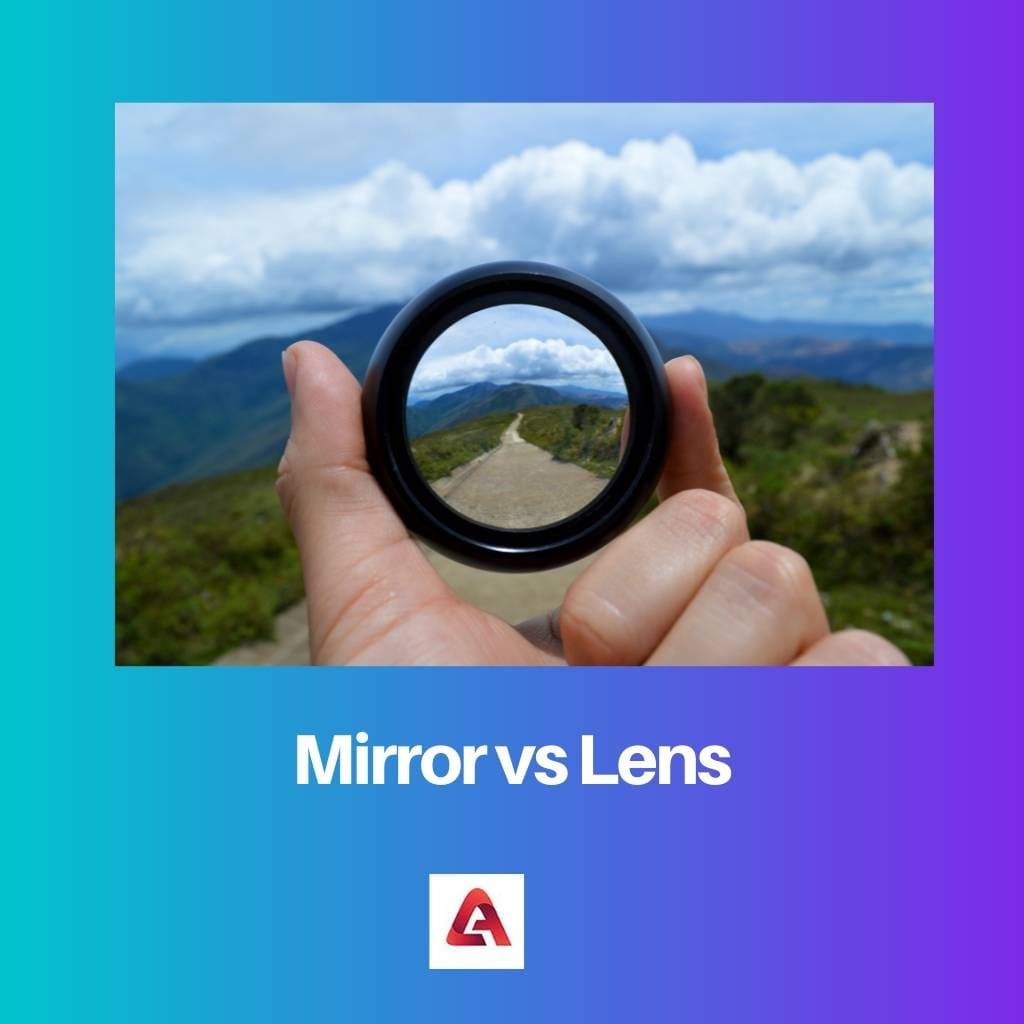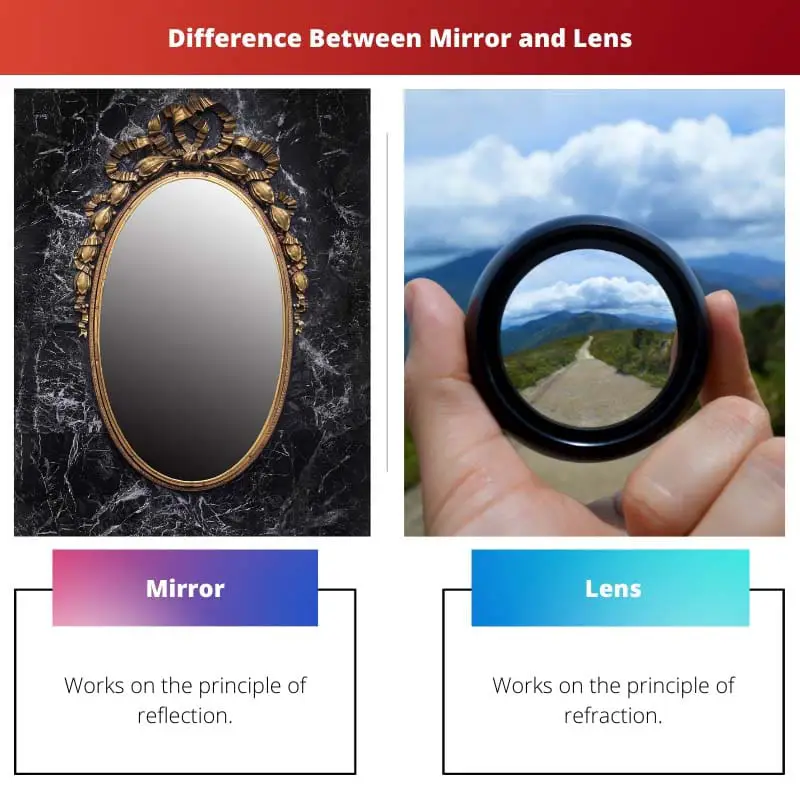The use of a mirror can be traced back to 4000 BC when water was put in a dark bowl or container. The first use of the lens can be traced back to 1888 and was used for correcting vision. Even today, mirrors and lenses find use in many areas.
They are made in different shapes and sizes depending on their needs and wants.
We use a mirror every day to look at ourselves. A lens is used in telescopes. It helps us to understand space and the universe. With the help of these, we have been able to uncover many secrets of the universe.
Key Takeaways
- Mirrors reflect light, while lenses refract light.
- Mirrors produce a virtual image, while lenses produce a real or virtual image.
- Mirrors have a flat or curved surface, while lenses have a convex or concave shape.
Mirror vs Lens
A mirror is an object with a reflective surface that creates a virtual image that is the same size and distance from the mirror as the object itself. A lens is a piece of curved glass or other transparent material that refracts or bends light to focus it and is used in a variety of applications.

The law of reflection describes how a mirror creates an image. It claims that when light strikes an opaque material and is bounced, the angle of reflection is equal to the incident ray, and in the center of these degrees is a perpendicular standard.
Everybody uses a lens in some form or another every day. They can be used to read small letters in a book with a magnifying glass, magnify or minimize images and bring blurry images into focus.
A lens is a transparent medium that comes in different shapes and is used to bend light in a specific way. This can mean that the rays either diverge or converge from a specific point.
Comparison Table
| Parameters of Comparison | Mirror | Lens |
|---|---|---|
| Principle | Works on the principle of reflection | Works on the principle of refraction |
| Image formation formula | 1/v+1/u=1/f | 1/v-1/u=1/f |
| Construction | Mostly opaque for light reflection | Mostly transparent for image formation |
| Focal points | A plane mirror has no focal point | Has to focal points, F and 2F |
| Distance of the object | Measured from the pole(P) | Measured from the optical centre |
| Shape | A mirror can be both curved and plane depending upon the use | The lens is of the ellipsoid, biconvex shape. An ellipsoid is similar to a sphere but stretched out, like an olive, and biconvex means it’s rounded outward on both sides. |
What is Mirror?
Image formation by a mirror can be understood by the law of reflection. It states that when light hits an opaque surface and is reflected, the angle of reflection is equal to the incident ray, and there is a perpendicular normal in the middle of these angles.
Incident Ray- It is the ray of light that travels towards the opaque surface of the mirror and falls on it.
Reflected ray – It is the ray of light that is reflected back after hitting the opaque surface of the mirror. The incident ray and the reflected ray construct equal angles from the normal on either side of the normal.
Three main types of mirrors are:
- Plane mirror-This is the most commonly used mirror. The light ray which hits them is reflected back at an angle of 90°. The image that you see in the mirror is reversed. This means that the right side appears to be the left side, and the left appears to be the right. This is called a mirror image.
- The convex mirror-This mirror forms a virtual image and is called in the outward direction.
- Concave mirror-Both real and virtual images can be formed. It bends outwards. If the image is placed at infinity, a highly diminished but real image is formed. If the object is placed between the focus and the pole, the image formed is highly magnified and virtual. This finds application in shaving mirrors.
Some other mirrors that are used in physics are:
- Rotating mirrors
- Inclined mirrors
- Spherical mirrors
Ray diagrams can also be built on paper to predict the position of the image formed by a mirror. The diagrams can also be used to predict the shape, size, and distance of the image and also whether it will be real or virtual.

What is Lens?
The lens is used in many ways every day. Some examples are camera lenses, prime lenses, telephoto lenses, eyeglass lenses, and contact lenses.
Lenses are made from plastic or glass, and the shape in which they are constructed decides whether the light passing through them will diverge or converge.
The law says that moving from a lower refractive index to a larger refractive index, for example, from air to water, the ray of light will be reflected in the direction of the normal of the surface vice versa is also true.
In real life, it can be difficult to understand the direction in which the ray of light is moving through the lens.
Ray diagrams become extremely useful in these cases as they can be used to determine the direction of movement of the light and also the place where the image will be formed based on the location of the lens and object.
This is done by using Snell’s law of refraction. Images formed by a lens can be of two types, a real image, and a virtual image.
A real image is formed when the rays of light from the lens actually converge at a point and are visible to the naked eye. This means that the image is formed on the receptors of the human eye, and the photo-sensitive cells actually pick it up.
A virtual image is formed when the rays of light through the lens make it look like they are coming from the virtual image. This means that if you follow the race of light backward, you will reach the point where they all converge.
In truth, these rays don’t actually converge at this location, and if a screen is placed at this point, an image will not be visible.

Main Differences Between Mirror and Lens
- Lens operates on the principle of refraction, while mirrors operate on the laws of reflection.
- 100% of the light is reflected and refracted in the case of an ideal mirror and lens, respectively.
- There are mainly 6 different types of the lens, while the mirror exists only in broadly concave and convex mirrors.
- The lens has 2 focal points, while a plane mirror has 0 focal points.
- 1/v-1/u=1/f is the formula for image formation by a lens. On the other hand, 1/v+1/u=1/f is the formula for image formation by a mirror.


The description of mirrors and lenses provides a comprehensive overview of the fundamental concepts and applications of these optical devices, highlighting their importance in science and everyday life.
Absolutely, the article effectively captures the essence of mirrors and lenses and their role in scientific advancements.
The explanation of how mirrors and lenses form images, along with the different types of mirrors, offers valuable insights into the functioning of these optical elements.
Indeed, the details about the types of mirrors and the principles of image formation are both fascinating and educational.
The detailed comparison between mirrors and lenses, along with the information about their shapes and principles, enriches the understanding of these optical devices and their functionalities.
Indeed, the article presents a comprehensive overview of mirrors and lenses while highlighting their distinct features and advancements in optics.
The use of mirrors and lenses dates back to thousands of years and have been increasingly used in different fields over time. Mirrors and lenses are not only used in everyday life, but they have also played a crucial role in making discoveries and understanding the universe better.
Absolutely! The historical significance and scientific importance of mirrors and lenses are truly remarkable.
It’s intriguing how the principles of reflection and refraction are employed in the functioning of mirrors and lenses, and how they differ in creating images.
Absolutely, the science behind mirrors and lenses is fascinating and has led to numerous scientific advancements.
The comparisons provided between mirrors and lenses are insightful and help in understanding their distinctive characteristics.
The everyday applications of lenses, such as eyeglasses and camera lenses, demonstrate the significant role of lenses in enhancing vision and imaging technology.
Absolutely, lenses have become indispensable in various optical instruments and devices, contributing to advancements in imaging and vision correction.
The detailed explanation of the principles behind mirrors and lenses, along with their different applications, provides a profound understanding of these optical elements and their contributions to science and technology.
Absolutely, the insights provided into the science and applications of mirrors and lenses are truly enlightening.
Agreed, the article effectively captures the significance of mirrors and lenses in various scientific and practical domains.
Mirrors and lenses, each with unique properties, have greatly contributed to the advancements of various technologies and scientific understanding.
Indeed, the applications of mirrors and lenses in optics, astronomy, and many other domains are remarkable.
The diverse applications of lenses, from magnifying glass to camera lenses, demonstrate the versatility and significance of this optical element in daily life and various scientific fields.
I agree, the practical implementations of lenses have greatly impacted technological innovations in different sectors.
Absolutely, lenses have revolutionized optics and are integral to various imaging devices.
The detailed comparison table between mirrors and lenses effectively illustrates the differences in their principles and properties, offering a clear understanding of their mechanisms.
Agreed, the comparison serves as a valuable reference for comprehending the unique features of mirrors and lenses.